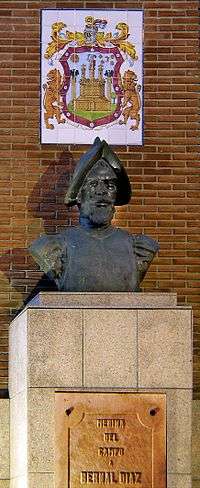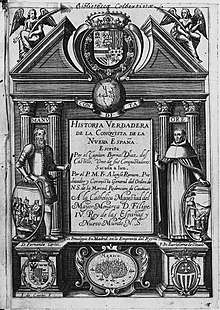Bernal Díaz del Castillo
Bernal Díaz del Castillo (c. 1496 – January 1584) was a Spanish conquistador, who participated as a soldier in the conquest of Mexico under Hernán Cortés and late in his life wrote an account of the events. As an experienced soldier of fortune, he had already participated in expeditions to Tierra Firme, Cuba, and to Yucatán before joining Cortés. In his later years he was an encomendero and governor in Guatemala where he wrote his memoirs called The True History of the Conquest of New Spain. He began his account of the conquest almost thirty years after the events and later revised and expanded it in response to the biography published by Cortes's chaplain Francisco López de Gómara, which he considered to be largely inaccurate in that it did not give due recognition to the efforts and sacrifices of others in the Spanish expedition.
Bernal Díaz del Castillo | |
|---|---|
 A 1904 depiction of Díaz | |
| Born | c. 1492 |
| Died | January 1584 (aged c. 92) |
| Nationality | Spanish |
| Occupation | Conquistador |
| Known for | Spanish conquest of the Aztec Empire |

Early life
Bernal Díaz del Castillo was born around the year 1496 in Medina del Campo, a prosperous commercial city in Castile. His parents were Francisco Díaz del Castillo and María Díez Rejón. His father was a regidor (city councilor) of Medina del Campo which provided the family with some prominence. Díaz had at least one older brother and they attended school together, learning to read and write. Bernal Diaz was intelligent and later showed a knack for languages, learning to speak the native dialect in Cuba, Nahuatl in Mexico, and the Cakchiquel language of the Guatemalan natives.[1]
In 1514, when Díaz was about eighteen years old, he left home to join an expedition to the New World led by Pedrarias Dávila. It was the largest fleet yet sent to mainland America, consisting of 19 vessels and 1,500 persons. Díaz served as a common foot soldier and hoped to make his fortune but when they reached Darien in present-day Colombia, they were quickly overcome by famine and an epidemic that killed more than half of the settlers.[2] Many of the colonists grew discouraged and looked elsewhere for new opportunities; some returned to Spain while others sailed to Hispaniola or Cuba.[1]
Expedition to Yucatán
In 1516, Diaz sailed to Cuba with about 100 other soldiers looking for a share of the gold and native laborers that were said to be found on the island. They discovered that gold was scarce and the native labor was in short supply, leading Díaz, in 1517, to join an expedition organized by a group of about 110 disaffected soldiers and settlers to "discover new lands".[3] They chose Francisco Hernández de Córdoba, a wealthy Cuban landowner, to lead the expedition. It was a difficult venture and, after sailing from Cuba for 21 days, they came across the Yucatán coast in early March 1517, on the Cape Catoche.
On March 4, 1517, the Spanish had their first encounter with the Yucatán natives who came to meet them on five or perhaps 10, depending on the version/translation of his work, large wooden canoes. The next day, the Spaniards disembarked, invited by the natives who wanted to show them their village. They were ambushed but managed to retreat, after killing 15 locals and having 15 wounded, 2 of whom later died. Upon leaving, the Spaniards captured 2 natives who would be translators in future expeditions. The Spanish almost died of thirst and sailed to Florida in search of potable drinking water. As they were digging a well on the beach, the Spaniards were attacked by locals. During this fracas, one Spaniard was captured by the native Floridians while the Spanish killed 22 natives. The Spanish managed to make a retreat but were also able to gather some water. They returned to Cuba, all of them severely wounded. The captain, Francisco Hernández de Córdoba, and other soldiers died shortly after making it back to Cuba.
Nevertheless, Díaz returned to the coast of Yucatán in April 1518, in an expedition led by Juan de Grijalva, with the intent of exploring the lands. Upon returning to Cuba, he enlisted in a new expedition, this one led by Hernán Cortés.
Conquest of Mexico
In this third effort, Díaz took part in the campaigns against the Mexica, later called the Aztec Empire. By this time, he was a highly experienced member of Hernán Cortés's expedition. During this campaign, Díaz spoke frequently with his fellow soldiers about their experiences. These accounts, and especially Díaz's own experiences, served as the basis for the recollections that Bernal Díaz later told with great drama to visitors and, eventually, a book entitled Historia verdadera de la conquista de la Nueva España (English: The True History of the Conquest of New Spain). In the latter, Díaz describes many of the 119 battles in which he claims to have participated in, culminating in the defeat of the Aztecs in 1521.
This work also claims to describe the diverse native peoples living in the territory renamed New Spain by the Spaniards. Bernal Díaz also examines the political rivalries of Spaniards, and gives accounts of the natives' human sacrifices, cannibalism and idolatry, which he claims he witnessed first-hand, as well as the artistic, cultural, political and intellectual achievements of the Aztecs, including their palaces, market places and beautifully organized botanical and zoological gardens. His account of the Mexica along with that of Cortés are first-person accounts recording important aspects of Mesoamerican culture. Bernal Díaz's account has not been fully utilized as a source for conquest-era Mesoamerican culture.[2]
Governor of Antigua Guatemala
As a reward for his service, Díaz was awarded an encomienda by Cortés in 1522. That was confirmed and supplemented by similar awards in 1527 and 1528.[4] In 1541, he settled in Guatemala and, during the course of a trip to Spain, was appointed regidor (governor) of Santiago de los Caballeros de Guatemala, present-day Antigua Guatemala, in 1551.
True History

His Historia verdadera de la conquista de la Nueva España, finished in 1568, almost fifty years after the events it described, was begun around the same time as his appointment as regidor and was well in progress by the mid-1550s when he wrote to the Holy Roman Emperor (and king of Spain), Charles V, describing his services and seeking benefits. That was a standard action of conquerors to document their services to the crown and requests for rewards.
Some version of his account circulated in central Mexico in the 1560s and 1570s, prior to its seventeenth-century publication. Bernal Díaz's account is mentioned by Alonso de Zorita, a royal official who wrote an account of indigenous society, and mestizo Diego Muñoz Camargo, who wrote a full-length account of the Tlaxcalans' participation in the conquest of the Mexica.[2] Bernal Díaz's manuscript was expanded in response to what he later found in the official biography of Hernán Cortés commissioned by Cortés's heir, Don Martín Cortés, published in 1552 by Francisco López de Gómara. The title Historia verdadera (True History) is in part a response to the claims made by Hernán Cortés in his published letters to the king, López de Gómara, Bartolomé de las Casas, Gonzalo de Illescas and others who had not participated in the campaign. Bernal Díaz also used the publication of Juan Ginés de Sepúlveda on just war, which allowed Bernal Díaz to cast the conquest of Mexico as a just conquest.[2]
Despite Bernal Díaz's lack of formal education and the self-interest that gave birth to his volume, the Historia verdadera evokes, like no other source, the often tragic and painful yet fascinating process through which one empire ended and another began to take shape.[5]
Death
Bernal Díaz died in January 1584. He was alive on January 1st, but on January 3rd, his son, Francisco, appeared before the Cabildo of Guatemala and informed them that his father had died.[6] Miguel León-Portilla accepts this date in his Introduction (dated July 1984 "a cuatro siglos de la muerte de Bernal") to the anthology of extended excerpts from the Historia verdadera.[7] Alicia Mayer (2005) praised that edition, its selection, and León-Portilla's introduction, saying they remained, down to the date of her review, "fuente imprescindible de consulta" (an indispensable source to consult) without seeing his manuscript published. An expanded and corrected copy of the manuscript kept in Guatemala was sent to Spain and published, with revisions, in 1632. The manuscript was edited by Fray Alonso de Remón and Fray Gabriel Adarzo y Santander prior to publication. In this first published edition of Bernal Díaz's work, there is a chapter (212), which some consider apocryphal with signs and portents of the conquest and omitted from later editions.[2]
Notes
- Cerwin (1963)
- Rolena Adorno, "Bernal Díaz del Castillo", Oxford Encyclopedia of Mesoamerica, David Carrasco, ed. New York: Oxford University Press, 2001, vol. 1, p. 323.
- Weddle (1985)
- Carmelo Saenz de Santa María, Historia de una historia: la crónica de Bernal Díaz del Castillo. Madrid: Consejo Superior de Investigaciones Científicas, 1984, pp. 89–90
- David A. Boruchoff, "Beyond Utopia and Paradise: Cortés, Bernal Díaz and the Rhetoric of Consecration." M L N [Modern Language Notes] 1991, 106, 2. pp. 330-369
- Henry R. Wagner, "Notes on Writings by and about Bernal Díaz del Castillo", The Hispanic American Historical Review, Vol. 25, No. 2 (May, 1945), pp. 199-211, at p. 207.
- published in 1988 by Conaculta (Consejo nacional para la cultura y las artes) in its series "100 de México", p. 31.
References
- Boruchoff, David A. (1991). "Beyond Utopia and Paradise: Cortés, Bernal Díaz and the Rhetoric of Consecration". Modern Language Notes. 106 (2): 330–369.
- Cerwin, Herbert (1963). Bernal Diaz: Historian of the Conquest. University of Oklahoma Press.
- Montoya, Claudia (2005). "Bernal Diaz del Castillo". In Kaplan, Gregory B. (ed.). Sixteenth-Century Spanish Writers. Dictionary of Literary Biography Vol. 318. Gale.
- Prescott, William H. (1843). History of the Conquest of Mexico, with a Preliminary View of Ancient Mexican Civilization, and the Life of the Conqueror, Hernando Cortes (online reproduction, Electronic Text Center, University of Virginia Library). New York: Harper and Brothers. OCLC 2458166.
- Rabasa, José (2008). "Díaz del Castillo, Bernal (c. 1495–1584)". Encyclopedia of Latin American History and Culture. Charles Scribner's Sons.
- Thomas, Hugh (1993). Conquest: Montezuma, Cortes, and the Fall of Old Mexico. Simon & Schuster.
- Wagner, Henry R. (1945). "Notes on Writings by and about Bernal Díaz del Castillo". Hispanic American Historical Review. 25 (2): 199–211.
- Weddle, Robert S. (1985). Spanish Sea: the Gulf of Mexico in North American Discovery. Texas A&M University Press.
- "Bernal Diaz del Castillo". Encyclopedia of World Biography. Gale. 1998.
- Díaz del Castillo, Bernal (1963) [1632]. The Conquest of New Spain. Penguin Classics. J. M. Cohen (trans.) (6th printing (1973) ed.). Harmondsworth, England: Penguin Books. ISBN 0-14-044123-9. OCLC 162351797.
- Díaz del Castillo, Bernal (2005) [1632]. Historia verdadera de la conquista de la Nueva España (in Spanish). Felipe Castro Gutiérrez (Introduction). Mexico: Editores Mexicanos Unidos, S.A. ISBN 968-15-0863-7. OCLC 34997012.
- Saenz de Santa María, Carmelo. Historia de una historia: la crónica de Bernal Díaz del Castillo. Madrid: Consejo Superior de Investigaciones Científicas, 1984.
- Mayer, Alicia (2005). "Reseñas: Bernal Díaz del Castillo, Historia verdadera de la conquista de la Nueva España (Manuscrito Guatemala)" (PDF). Estudios de Historia Novohispana (in Spanish). 33: 175–183. ISSN 0425-3574. Archived from the original (PDF) on 2007-03-06.
External links
| Wikisource has original works written by or about: Bernal Díaz del Castillo |
- Works by Bernal Díaz del Castillo at Project Gutenberg
- Works by Bernal Díaz del Castillo at LibriVox (public domain audiobooks)

- Works by or about Bernal Díaz del Castillo at Internet Archive
- La Historia verdadera de la conquista de la Nueva España (in Spanish)
